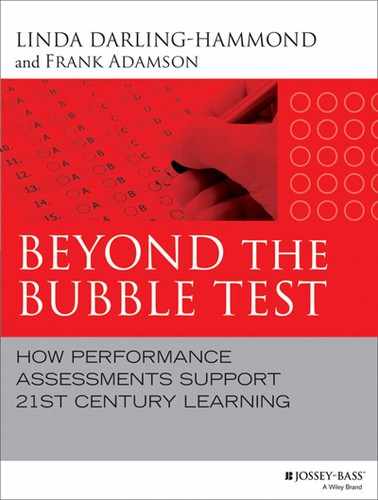Book Description
Performance assessment is a hot topic in school systems, and educators continue to analyze its costs, benefits, and feasibility as a replacement for high-stakes testing. Until now, researchers and policymakers have had to dig to find out what we know and what we still have to learn about performance assessment. Beyond the Bubble Test: How Performance Assessments Support 21st Century Learning synthesizes the latest findings in the field, and not a moment too soon.
Statistics indicate that the United States is in danger of falling behind if it fails to adapt to our changing world. The memory and recall strategies of traditional testing are no longer adequate to equip our students with the skills they need to excel in the global economy. Instead teachers need to engage students in deeper learning, assessing their ability to use higher-order skills.
Skills like synthesizing information, understanding evidence, and critical problem-solving are not achieved when we teach to multiple-choice exams. Examples in Beyond the Bubble Test paint a useful picture of how schools can begin to supplement traditional tests with something that works better. This book provides new perspectives on current performance assessment research, plus an incisive look at what's possible at the local and state levels.
Linda Darling-Hammond, with a team of leading scholars, bring together lessons learned, new directions, and solid recommendations into a single, readily accessible compendium. Beyond the Bubble Test situates the current debate on performance assessment within the context of testing in the United States. This comprehensive resource also looks beyond our U.S. borders to Singapore, Hong Kong, and other places whose reform-mindedness can serve as an example to us.
Table of Contents
- Acknowledgments
- The Authors
- Chapter 1: Introduction: The Rationale and Context for Performance Assessment
- Part One: Through a Looking Glass: Performance Assessment Past, Present, and Future
- Chapter 2: Looking Back: Performance Assessment in an Era of Standards-Based Educational Accountability
- Arguments for Performance Assessment
- Defining Performance Assessment
- Types of Performance Assessments
- Recent History of Performance Assessment in Large-Scale Testing
- Research Findings
- Current Examples of Large-Scale Performance Assessments
- Performance Assessment in the Context of Standards-Based Accountability
- Recommendations
- Notes
- Chapter 3: Where We Are Now: Lessons Learned and Emerging Directions
- Chapter 4: Reaching Out: International Benchmarks for Performance Assessment
- Chapter 2: Looking Back: Performance Assessment in an Era of Standards-Based Educational Accountability
- Part Two: Advances in Performance Assessment: Assessing and Supporting Learning
- Chapter 5: Performance Assessment: The State of the Art
- Chapter 6: Adapting Performance Assessments for English Language Learners
- Performance Assessments and English Language Learners
- How Performance Assessments Can Be Made Most Valid for ELLs
- Scoring Performance Assessment Tasks
- Using Performance Assessments to Improve Teaching Quality
- Informing Teaching through Performance Assessment
- Assessing English Language Proficiency
- Classroom Performance Assessment in Action
- Conclusion
- Chapter 7: Supporting Teacher Learning through Performance Assessment
- Part Three: Policy and Performance Assessment: Developing Systems That Can Work
- Chapter 8: A New Conceptual Framework for Cost Analysis
- Chapter 9: Investing in Assessments of Deeper Learning: The Costs and Benefits of Tests That Help Students Learn
- Chapter 10: Building Systems of Assessment for Deeper Learning
- Assessing Where We’ve Been and Where We Are Going
- Defining College and Career Readiness
- Developing Systems of Assessment
- Why Is a System of Assessments Important?
- How Might States Develop Systems of Assessment?
- A Continuum of Assessments
- How Can Assessment Be Made Useful for Students as Well as Adults?
- New Systems of Accountability
- Conclusion and Recommendations
- Notes
- Chapter 11: Concluding Thoughts: Creating Next-Generation Assessments That Last
- Appendix A: State Performance Tasks
- Appendix B: New Approaches to Performance Assessment
- Appendix C: A Framework for Measuring the Costs, Expenditures, and Benefits of Performance Assessment
- Appendix D: Spending for Interim Testing at the Local District Level
- References
- Name Index
- Subject Index
- End User License Agreement
